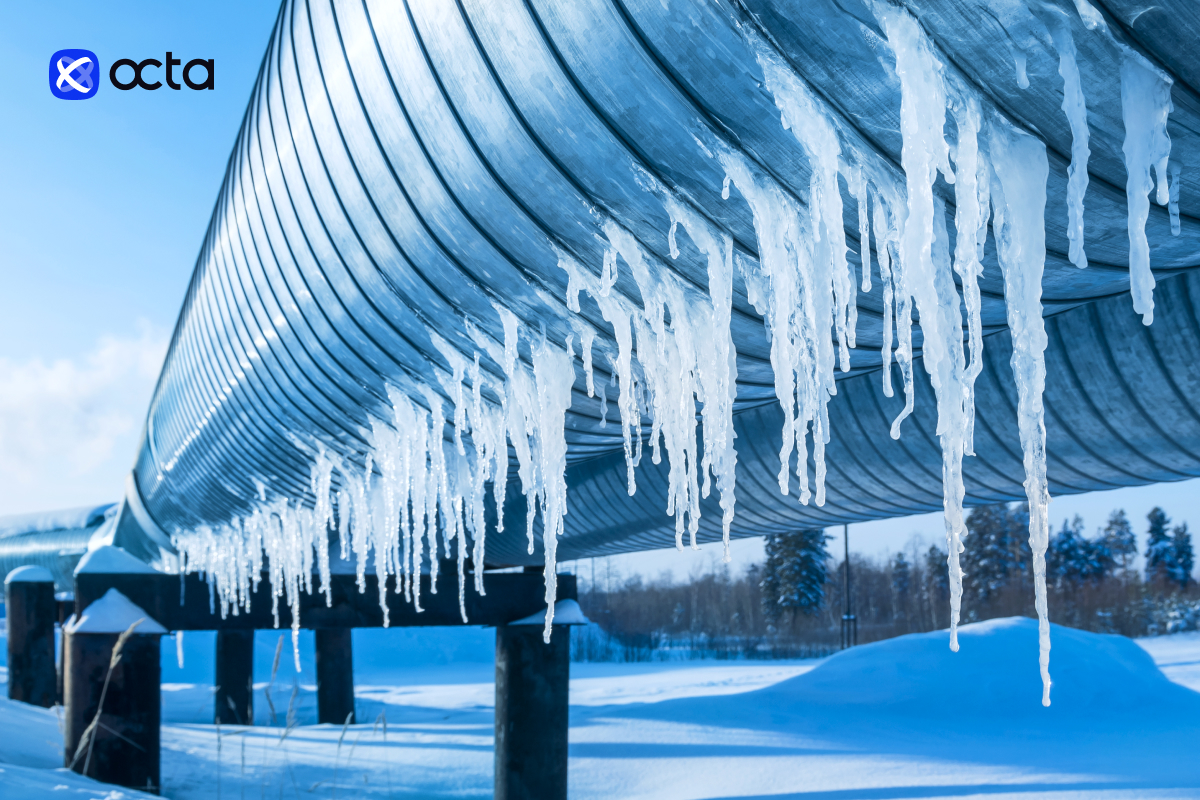Energy crisis in Europe appears to be over, but problems remain
Europe has managed to survive the most acute phase of the energy crisis, but the future is still very uncertain.
- For approximately 500 days (in 2021–2023), Europe was gripped by an unprecedented energy crisis that was characterised by record-high prices—especially for natural gas.
- Supply issues induced by the changing geopolitical landscape have been the central cause of the crisis.
- After reaching an extraordinarily high level of €311 per MWh in the summer of 2022, natural gas prices have dropped by more than 80% by winter 2023, but they still remain more than two times higher than their long-term historical average.
- Europe has managed to withstand the most acute phase of the crisis but at a rather large cost.
- Overall, Europe has adapted and managed to accumulate substantial natural gas inventories, but the situation remains fragile and prices volatile.
- Although the probability of an energy crisis returning this winter is relatively low, such possibility still remains.
KUALA LUMPUR, MALAYSIA - Media OutReach Newswire - 20 December 2023 - While there are many aspects of the energy crisis in Europe within several markets, including crude oil, coal, electricity, and emission allowances, as well as within several domains, such as EU energy policies and regulation, diplomacy and international relations, this article will focus exclusively on the natural gas market, because it is here where the energy crisis has been most pronounced.

Europe faced an unprecedented energy crisis for around seventeen months (from September 2021 to February 2023), as coal, natural gas, and electricity prices surged to all-time highs. Governments across the continent rushed in to introduce energy-saving measures and implement conservation policies, while households and businesses had to cut consumption rapidly.
Moreover, the conflict in Ukraine has disrupted energy supplies as the European Union (EU) has prohibited the maritime transport of Russian crude oil and has set a target for the bloc to phase out imports from Russia by 2027. Furthermore, three of the four lines of the Nord Stream pipeline were damaged by unknown explosions, limiting Europe's supply options. Either way, importing cheap pipeline gas from Russia no longer seems like a viable option for Europe as relations between the two actors remain strained.
Now, as 2023 draws to a close, can we confidently conclude that the energy crisis in Europe is over? How prepared is Europe to cope with the upcoming winter? What are the risks and challenges that lie ahead?
History
Kar Yong Ang, Octa analyst, has succinctly summarised the context: ‘Europe's energy crisis was long in the making. As the global economy recovered from the recession caused by COVID-19, the demand for LNG [liquified natural gas] surged in the summer of 2021. However, the supply could not immediately cope with the rising demand, so prices across the globe went up. Higher prices, coupled with LNG supply constraints and sluggish European production, prevented the European states from restocking natural gas to adequate levels before the winter. Another shock came in December 2021, when gas flows from Russia along the Yamal Europe route dropped sharply—ostensibly due to maintenance. Then, as you know, the armed conflict in Ukraine broke out, taking the whole continent to a totally different reality and sending energy costs to the stratosphere.’
The energy crisis's most acute phase occurred in the summer of 2022. One only needs to look at the evolution of Europe's benchmark natural gas price (TTF) to assess the scale of the emergency (see the chart above). On 25 August 2022, TTF price reached €311 per megawatt-hour (MWh), the highest level ever recorded. On that specific day, the price was 44% above the previous maximum reached on March 7, 2022, and was a staggering 18 times higher than the three-year average price recorded over 2019-2021. Despite Europe's gas storage sites being 78% full in August 2022, supply worries were rife as imports from Russia dropped by around 60%, forcing Europe to rely extensively on liquefied natural gas (LNG) imports—especially from the United States. However, the aggregate supply of LNG in the global market at that time was reduced as one of the U.S. LNG export plants—Freeport LNG—had to go offline due to an explosion incident. Thus, to secure an adequate number of LNG cargoes, Europe had to outbid other customers in South and East Asia by agreeing to pay higher prices to suppliers.
A lot has changed since last summer. Europe has adopted and managed to reduce demand, find new suppliers and build natural gas stocks to comfortable levels. The European gas prices have returned to normality but remain above the level observed before the crisis. On Monday, 6 December, the front-month futures contract for delivery in January at TTF settled at €39.25 per MWh, 87% below the peak observed in August 2022 but still some two times above the historical average seen in 2019-2021. Kar Yong Ang, Octa analyst singles out several reasons for normalisation:
‘Although natural gas prices in Europe remain higher than they were before the crisis, the situation has improved dramatically. Indeed, the contrast with 2022 looks quite impressive. There are several reasons for this. First, there was a structural loss of demand partly due to reduced economic activity and partly due to conservation policies. Second, imports of pipeline gas from Norway have increased, as well as LNG imports from the United States and other countries. On top of it, there was a bit of luck as well, as weather conditions allowed the Europeans to build the stocks faster than normal.’
Indeed, probably the most painful yet effective adjustment that Europe had to endure was the loss of demand. According to Eurostat, total gas use in the EU's top 6 consuming countries—Germany, Italy, France, Netherlands, Spain, and Poland—was down by 17% in the first ten months of 2023 compared with the five-year average for 2017-2021. Obviously, energy-intensive industries such as chemicals and steel production had to bear the brunt of adjustment. For example, according to Statistisches Bundesamt, Germany's energy-intensive manufacturing production has decreased by about 20% since the start of 2022 and has not shown any signs of recovery yet.
At the same time, however, as consumption went down, so did local supply. According to Eurostat, total indigenous production in the EU's top 6 gas-producing countries—Germany, Italy, Hungary, Netherlands, Poland, and Romania—was down by 41% in the first ten months of 2023 compared with the five-year average for 2017-2021. The key reason for the continuing drop in production in Europe is the gradual phasing out of the Groningen natural gas field, Europe's largest one, where a series of earthquakes led the government to shut down production.
Thus, Europe had to rely on imports more and more to balance its natural gas market. Russia has long been the main supplier of affordable pipeline gas into Europe, but geopolitical tensions, sanctions, and explosions of the Nord Stream pipeline have brought the flows to a minimum. According to Eurostat, Russia exported just 22.3 billion cubic metres of natural gas into Europe in the first nine months of 2023, which is 57% lower than during the same period in 2022 and 65% lower than during the same period in 2021. Concurrently, imports of LNG from the United States reached 30.01 billion cubic metres during the first nine months of the year, up a whopping 185% from the same period in 2021.
Another factor that helped Europe fill the supply gap and live through the volatile months of 2022 was pure luck. Indeed, the unusually warm winter in 2022–2023 lowered the heating demand and allowed the European states to start building stocks earlier than usual. This year's weather conditions have also been quite favourable. Windy and wet weather increased electricity generation from renewable sources, while mild temperatures in November have delayed the onset of winter heating.
‘Overall, Europe has managed to bring its natural gas inventories to a rather comfortable level and is now well-protected to withstand future supply shocks,’ says Kar Yong Ang, Octa analyst. Indeed, according to the latest data from Gas Infrastructure Europe, gas storage levels are at record highs for this time of the year at around 94% full, said Octa analyst, adding that the general bias for TTF price remains bearish. ‘I would not be surprised to see European natural gas prices drop to €30 per MWh in case of a normal winter. Alternatively, if this upcoming winter turns out to be colder than normal, we might see TTF temporarily hitting €60 per MWh.’
However, Kar Yong Ang says that different kinds of challenges and risks lie ahead for Europe. ‘Some European states have secured a number of long-term import deals with major LNG producers, which, on the face of it, is a good thing. But, it appears that Europe is placing too much faith in LNG. It's betting too much on a single supply source, which may backfire in the long run. If Europe is to permanently replace relatively cheap pipeline imports from Russia with relatively expensive LNG imports, then, I am afraid, economic activity in its traditional industries may never recover to the pre-crisis levels, and in fact, deindustrialisation may kick in full force.’
Indeed, Europe's top competitors—the United States and China—benefit from lower prices. The United States has ample resources at home, while China is getting cheap imports from Russia. Europe risks losing its competitive standing in the global marketplace. Furthermore, as we explained at the beginning of the article, the temporary shutdown of a single LNG export plant in the U.S. has already highlighted how strongly European energy security is now connected with the intricacies of the global LNG market. ‘All 27 member states of the EU have been net importers of energy since 2013, and this status is unlikely to change in the foreseeable future. With supply options more limited than in the past, European consumers will have to get used to more volatile natural gas prices, as they will increasingly be determined by the whims of the weather and by the bargaining power of other LNG importers in Asia,’ says Kar Yong Ang, Octa analyst.
Europe has survived the energy crisis and managed to adapt but has done so at the cost of lower demand and reduced economic activity. Now, Europe will have to learn to navigate the global LNG trade successfully to secure the most favourable deals.
Hashtag: #Octa
The issuer is solely responsible for the content of this announcement.
Octa
Octa is an international broker that has been providing online trading services worldwide since 2011. It offers commission-free access to financial markets and various services already utilised by clients from 180 countries who have opened more than 42 million trading accounts. Free educational webinars, articles, and analytical tools they provide help clients reach their investment goals.
The company is involved in a comprehensive network of charitable and humanitarian initiatives, including the improvement of educational infrastructure and short-notice relief projects supporting local communities.
In the APAC region, Octa captured the ‘Best Forex Broker Malaysia 2022' and the ‘Best Global Broker Asia 2022' awards from Global Banking and Finance Review and International Business Magazine, respectively.







